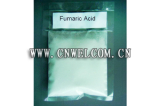Fumaric Acid
-
- Category :
Food and Feed additives/Food additives
- CAS NO : 110-17-18
- EC NO : 203-743-0
- Molecular Formula : C4H4O4
- Main Specifications : food/feed grade
- Synonyms : trans-2-Butenedioic acid;L-Fumaric Acid;
Package: 25kgs/PP bag
Uses : Used mainly in the synthesizing pharmaceutics unstaturated polyester resins, coating, plasticizers, L-malic acid, L-aspartic acid, etc, also used as foodstuff additives.
Molecular Structure:

Product description:
Fumaric Acid
Synonyms: Fumerate, allomaleic acid, 2-butenedioic acid, trans-butenedioic acid, boletic acid, lichenic acid, trans-1, 2-ethenedicarboxylic acid
Chemical Formula: C4H4O4
CAS No: 110-17-8
HS Code: 291719300
Appearance: White or colorless crystals with sour of fruit
Items Standard
Purity (dry basis) % 99.5-100.5
Melting Point ° C 286-302
Colour (APHA)≤ 15
Moisture%≤ 0.50
Ash %≤ 0.05
Sulfate %≤ 0.01
Heavy Metal(as Pb)PPM≤ 10
Arsenic(as As) PPM≤ 3
Chloride PPM≤ 50
Usage:
Fumaric acid is white powder, and is an organic (carbon-containing) food acid. It is one of the most common acids found in nature where it acts as a key ingredient in organic acid biosynthesis (the Krebs cycle). It can be prepared by catalytic oxidation of benzene or by bacterial action on glucose. It is found in small amounts in a variety of plants and is essential to the respiration of animal and vegetable tissue.
This chemical is used as a substitute for tartaric acid in beverages and baking powder. It is used as a mordant in dyeing and in the manufacture of synthetic resins and polyhydric alcohols. This product is added to a variety of foods as an acidifier, curing accelerator and flavoring agent.
